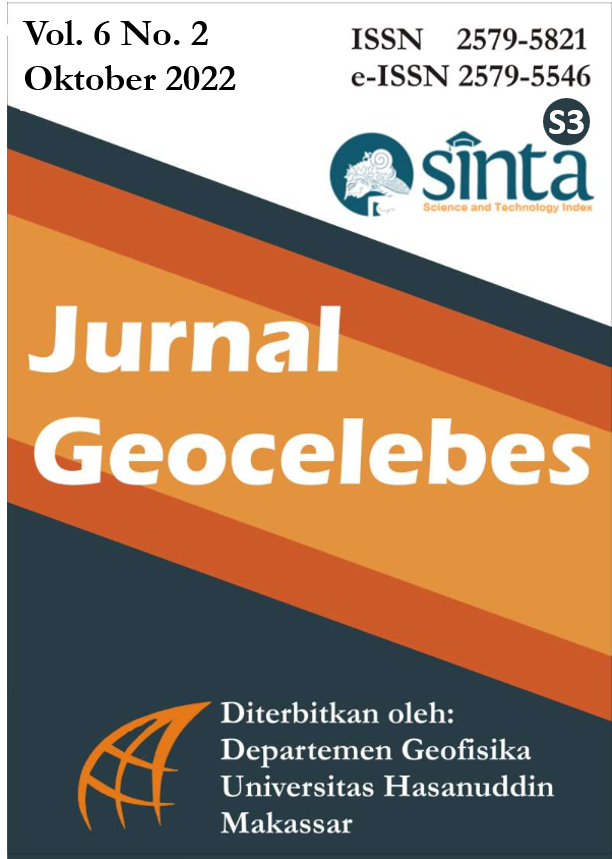Analysis of Productivity Synchronization of Barge Transportation Equipment and Crane Loading on Nickel Ore Delivery Activities in PT. Antam Nickel UBP North Maluku
Analisis Sinkronisasi Produktivitas Alat Angkut Tongkang dan Alat Muat Crane pada Kegiatan Pengapalan Nickel Ore di PT. Antam UBP Nikel Maluku Utara
DOI:
https://doi.org/10.20956/geocelebes.v6i2.22043Keywords:
match factor, nickel ore, shipping, synchronizationAbstract
Nickel mining activities at PT. ANTAM North Maluku Nickel UBP is closely related to the production and distribution process. To achieve optimal production, nickel ore is loaded or shipped in accordance with the company's production targets. The study aims to determine the compatibility value of barges and crane loading equipment in the shipping process and to determine the factors that affect the productivity of nickel ore shipments. The research method used is descriptive quantitative method, where the analysis process is based on distribution table data, average values, and percentages. This research was conducted at the Tanjung Buli Site in the MV. shipping process. Lumoso Karunia VIII. In this shipment, the stowage plan target is 55255 tons which must be completed within a maximum of 10 days. The results of the calculation of the compatibility of crane loading equipment in MV. Lumoso Karunia VIII and barge transportation have a match factor value of 0.72 or <1. Factors that affect the decline in the shipping process are work efficiency time, the value of the match factor and rainy time. From the calculation results, the work efficiency time obtained is 65.94% or less efficient. The value of the match factor <1 can conclude that the transportation equipment is busy while the loading equipment has a lot of idle time and rain constraints with an average amount of rain time of 206.6 minutes or 3.44 hours. However, the shipping process can reach the production target within 8 days with the capability of loading equipment productivity reaching 6997.95 tons/day.Downloads
References
Achmadi, A. dan Narbuko. 2015. Metodologi Penelitian. Jakarta: Bumi Aksara.
Karchely, V.A., Fadillah, A. dan Manullang, S. 2020. Analisis angkutan crude palm oil multi trip dengan kapal Tongkang. Jurnal Penelitian Transportasi Laut. 22(2), pp.79-86. https://doi.org/10.25104/transla.v22i2.1615
Pranata, R.Y., Djamaluddin, D., Asmiani, N. dan Thamsi, A.B. 2017. Analisis Perbandingan kadar Nikel Berdasarkan perencanaan terhadap realisasi penambangan. Jurnal Geomine, 5(3), pp.143-146. https://doi.org/10.33536/jg.v5i3.146
Prodjosumarto, P. 2000. Pemindahan tanah Mekanis. Bandung: Jurusan Teknik Pertambangan. Institut Teknologi Bandung.
Setiawan, K.N.S., Achmadi, T. dan Lazuardi, S.D. 2018. Analisis skala penambangan mineral dan pengangkutan: studi kasus angkutan nikel di Sulawesi Tenggara. Jurnal Teknik. 7(1), pp.43-48. http://dx.doi.org/10.12962/j23373539.v7i1.30001
Shaddad, A.R., Widodo, S. dan Asmiani, N. 2016. Analisis keserasian alat mekanis (match factor) untuk peningkatan produktivitas. Jurnal Geomine. 4(3), pp.111-117. https://doi.org/10.33536/jg.v4i3.74
Downloads
Published
How to Cite
Issue
Section
License
Authors who publish with this journal agree to the following terms:
- Authors retain copyright and grant the journal right of first publication with the work simultaneously licensed under a Creative Commons Attribution License that allows others to share the work with an acknowledgement of the work's authorship and initial publication in this journal.
- Authors are able to enter into separate, additional contractual arrangements for the non-exclusive distribution of the journal's published version of the work (e.g., post it to an institutional repository or publish it in a book), with an acknowledgement of its initial publication in this journal.
- Authors are permitted and encouraged to post their work online (e.g., in institutional repositories or on their website) prior to and during the submission process, as it can lead to productive exchanges, as well as earlier and greater citation of published work (See The Effect of Open Access).



